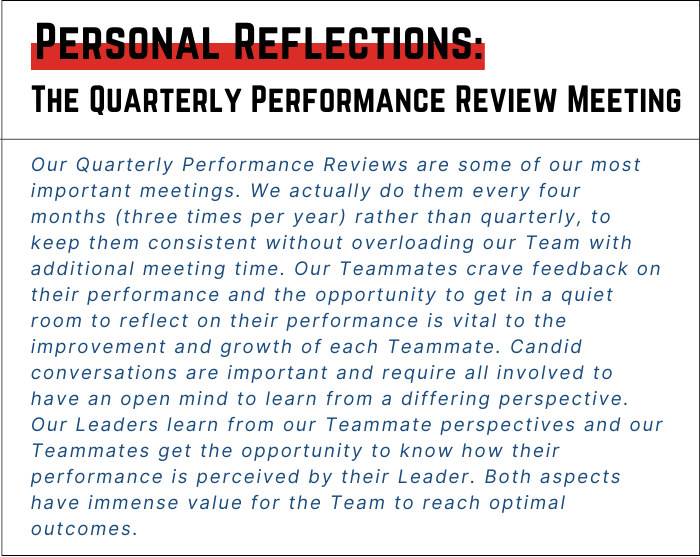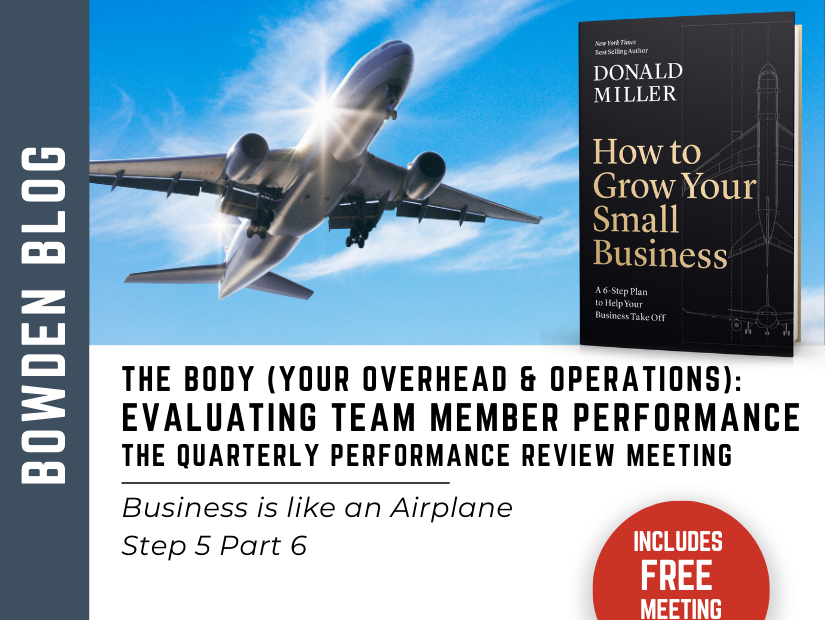Do all your Team members understand how they are performing in their roles? Does your performance review process intentionally review their performance, instead of judging them as a person? If you’re unsure or if there’s no systematic approach within your company, incorporating Quarterly Performance Review meetings into each department can offer valuable feedback.
In this Series, we’re reviewing the 6-Step Plan to run your business from Donald Miller’s latest book, How to Grow Your Small Business, and the online platform at businessmadesimple.com.
The analogy of an airplane is used to outline the 6 essential steps for effective business management. This week, we continue with the sixth step in the series, Step 5: “The Body – Your Overhead & Operations.” In this segment of Step 5, Don introduces the fifth meeting in the “Management & Productivity Made Simple Playbook”: The Quarterly Performance Review.
The primary purpose of this review is to ensure that each team member comprehends their job performance, enabling adjustments and improvements to enhance outcomes.
Establishing Quarterly Performance Reviews from the “Management & Productivity Made Simple Playbook” reduces the need for you, the company’s leader, to individually provide feedback to contributors within each department. It establishes a structured approach for Department Leaders to offer feedback on individual performances, comparing them to the expectations set for their personal priorities. This dialog empowers Department Leaders to manage their team members effectively as the company expands. The Quarterly Performance Review Meeting Template ensures a well-structured meeting that optimizes everyone’s time.
Step 5 – The Body (Your Overhead & Operations) – Evaluating Team Member Performance – The Quarterly Performance Review Meeting
Are Your Team Members Receiving Clear, Consistent Feedback on Their Performance?
In most cases, the leader designs the agenda and prepares to ensure meeting success. The Quarterly Performance Review stands out because both the team member and the leader share responsibility for completing the Quarterly Performance Review template. Within the template, both parties will:
- Evaluate the team member’s performance based on 5 Personal Priorities:
- Exceeded Expectations
- Met Expectations
- Didn’t Meet Expectations
- Provide additional comments for further perspective
- Assess whether the team member was prepared for the weekly Personal Priority Speed Checks
- Identify future opportunities for the team member’s growth and improvement
It’s crucial for both the team member and the leader to offer their performance assessment for each priority ahead of the meeting. This practice helps uncover any disparities between their viewpoints. Well-defined priorities that are time-bound, measurable, and specific enhance the effectiveness of the process. Moreover, for the system to function effectively, both participants in the conversation must be open to the feedback process.
The Feedback Process – Navigating Constructive Dialogue
With few exceptions, team members generally seek insights into their job performance. However, discussing underperformance can be uncomfortable. The feedback process demands that both the leader and the team member approach the conversation with openness and a willingness to learn.
Different team members respond to feedback and criticism differently. Some welcome it as they value feedback, while others resist any implication of imperfection. Hence, leaders must understand how to communicate with their team members. These meetings aim to offer constructive feedback to foster performance improvement. Team members struggling with feedback may feel uneasy and, if they’re resistant to change, might not be the right fit for the team. The Quarterly Performance Review offers a secure space for addressing these challenges and working through feedback-related concerns. The leader’s role is to manage these situations positively.
Given that both the team member and the leader complete the Quarterly Performance Review Template, they have a foundation for discussing their perspectives on the team member’s performance. The leader should approach the conversation with openness, recognizing that new information about the team member’s circumstances might emerge. The objective is to deliver a fair and impartial evaluation of the team member’s performance to facilitate future improvement.
Enhancing Performance, Avoiding Judgment
The Quarterly Performance Review centers on the team member’s 5 Personal Priorities and how well they were executed. Clearly defined priorities minimize subjectivity in evaluations, as they enable straightforward assessments of performance outcomes. Maintaining objectivity within the process is essential for the leader. Two scenarios could compromise objectivity and might benefit from your presence in the meeting:
- If the leader and a team member’s personalities clash, maintaining an objective and positive conversation could be challenging.
- Leaders inclined toward “people-pleasing” may struggle to provide direct or negative feedback, even when expectations were not met. Allowing subpar performance to go unaddressed harms the organization; constructive feedback must be given.
As the overall leader, you should be attuned to these situations and participate in meetings as necessary to ensure proper outcomes. Simultaneously, you should coach your leaders to manage the process independently.
The central idea of the Quarterly Performance Review is to enhance performance, not pass judgment on team members. It’s crucial to separate a team member’s performance from their character. Suggesting areas for performance improvement should not be equated with personal judgment. When both the leader and team member grasp this concept, feedback becomes a valuable gift intended to aid performance improvement, without causing hurt feelings.
You’ll be amazed by the impact of incorporating the Quarterly Performance Review from the “Management & Productivity Made Simple Playbook.” This quarterly management approach empowers department team members. By offering a structured process for managing departments, it allows you to focus on leading and scaling your company.

As leaders and team members jointly reflect on the team member’s performance in relation to their priorities, the leader can provide feedback to facilitate improvement. Utilizing the Quarterly Performance Review Meeting Template guarantees well-organized meetings, ensuring dedicated time to review each team member’s performance every quarter.
Final Thoughts
Step 5 from Donald Miller’s book, How to Grow Your Small Business, is the Body – Your Overhead & Operations. The Quarterly Performance Review is the final meeting among the five comprising the “Management & Productivity Made Simple Playbook.” Implementing Quarterly Performance Reviews within each department prevents the need for you to micro-manage the entire company, fostering unhindered growth. Effective management becomes challenging once you have more than 10 or 12 team members. Moreover, every member of your company benefits from direct performance feedback each quarter.
Implementing Quarterly Performance Reviews within each department prevents the need for you to micro-manage the entire company, fostering unhindered growth. Effective management becomes challenging once you have more than 10 or 12 team members. Moreover, every member of your company benefits from direct performance feedback each quarter. The template for the Quarterly Performance Review is available to download so that you can implement it in your company. After you fill out your information, you will receive the link to a downloadable PDF.

Step 5 guarantees effective management of your small business’s Body – Overhead & Operations, preventing limitations on your potential growth. The individuals on your team contribute significantly to your business’s success, and you want your business to elevate them to new heights of accomplishment. In the next installment, we’ll explore a few optional meetings from the “Management & Productivity Made Simple Playbook” that could prove beneficial based on your circumstances and business needs.

